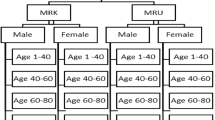Summary
Diagnosis Related Groups (DRG) are frequently used to standardize the comparison of consumption variables, such as length of stay (LOS). In order to be reliable, this comparison must control for the presence of outliers, i.e. values far removed from the pattern set by the majority of the data. Indeed, outliers can distort the usual statistical summaries, such as means and variances. A common practice is to trim LOS values according to various empirical rules, but there is little theoretical support for choosing between alternative procedures. This pilot study explores the possibility of describing LOS distributions with parametric models which provide the necessary framework for the use of robust methods.
Résumé
Les DRG (Diagnosis Related Groups) sont souvent utilisés pour standardiser des comparaisons entre variables d'utilisation des soins, telles que les durées de séjour (LOS). De telles comparaisons n'ont de sens que si l'on contrôle l'influence des outliers, c'est à dire d'observations éloignées de la majorité des données. La présence d'outliers a pour effet de diminuer la fiabilité des résumés statistiques habituels tels que moyenne arithméthique et variance. Une procédure communément utilisée est le trimming, le point de trimming étant choisi selon différents critères. Mais sans autres hypothèses, on n'a que peu de bases théoriques sur lesquelles s'appuyer pour comparer ces techniques et en choisir une. Le but de cette étude pilote est d'examiner la possibilité d'utiliser des modèles paramétriques pour décrire les distributions de durées de séjour. Ce n'est que dans ce cadre théorique qu'on pourra développer une procédure d'estimation robuste optimale.
Zusammenfassung
Die DRG (Diagnosis Related Groups) werden oft dazu benützt, um den Vergleich von Pflegeleistungen, wie etwa der Hospitalisationsdauer, zu standardisieren. In solchen Vergleichen muss der Einfluss von Ausreissern (d. h. Beobachtungen, die von der Mehrheit der Daten entfernt sind) berücksichtigt werden, da sonst die üblichen statistischen Werte (z. B. Mittelwerte und Abweichungen) unzuverlässig sind. In der Praxis, werden Ausreisser oft aufgrund von empirischen Kriterien ausgeschlossen. Es gibt aber wenige theoretische Grundlagen für solche Verfahren. Ziel dieser Pilotstudie ist die Anwendbarkeit parametrischer Modelle für die Hospitalisationsdauer- und somit die Grundlagen für die Anwendung robuster Verfahren —zu testen.
Similar content being viewed by others
References
Arons RR. The new economics of health care: DRGs, case mix and patients length of stay. New York: Praeger, 1987.
Blaco R. Analisi esploratoria degli outliers. In: SAS User Group Italia, Atti del 7o convegno annuale, Firenze: SUGITALIA 91, 1991.
Eggli Y, Grimm R, Paccaud F. Adaptation du “Grouper” aux Statistiques médicales VESKA (1980–1986), (Cahier de Recherches Doc. IUMSP No 22). Lausanne: IUMSP, 1987.
Gross AJ, Clark VA. Survival distributions: reliability applications in the biomedical sciences. New York: Wiley, 1975.
Marazzi A. Algorithms, routines and S functions for robust statistics Pacific Grove, Ca: Wadsworth & Brooks/Cole, 1992.
Commission on professional and hospital activities (CPHA). Length of stay in PAS hospitals by diagnosis, USA, 1977. Ann Arbor: CPHA, 1979.
Berki SE, Ashcraft MLF, Newbrander SC. Length of stay variations within ICDA-8 DRGs. Med Care 1984;22:126–142.
Koehn V, Eggli Y, Paccaud F. Comparaisons internationales des durées de séjour hospitalières. Méd et Hyg 1990;48: 385–388.
Cleary PD, Greenfields S, Mulley AG, Pauker SG, Schroeder SA, Wexler L, McNeil BJ. Variations in length of stay and outcomes for six medical and surgical conditions in Massachusetts and California. JAMA 1991;266:73–79.
Mushlin AL, Black ER, Connolly CA, Buonaccorso KM, Eberly SW. The necessary length of stay for chronic pulmonary disease. JAMA 1991;266:80–83.
Epstein AM, Bogen J, Dreyer P, Thorpe KE. Trends in length of stay and rates of readmission in Massachusetts: implications for monitoring quality of care. Inquiry 1991;21:19.
List ND, Fronczack NE Gottlieb SH, Baker RE. A crossnational study of differences in length of stay of patients with cardiac diagnoses. Med care 1983;21:519–530.
Author information
Authors and Affiliations
Rights and permissions
About this article
Cite this article
Ruffieux, C., Marazzi, A. & Paccaud, F. Exploring models for the length of stay distribution. Soz Präventivmed 38, 77–82 (1993). https://doi.org/10.1007/BF01318464
Issue Date:
DOI: https://doi.org/10.1007/BF01318464




